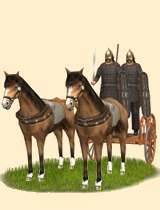Cidainh (Celtic Chariots)
 |
Weapons | Defence | Mental | ||||||
|---|---|---|---|---|---|---|---|---|---|
| Primary | Secondary | Armour: | 7 | Morale: | 16 | ||||
| Type: | spear | none | Shield: | 4 | Discipline: | impetuous | |||
| Attack: | 5 | 12 | Skill: | 11 | Training: | trained | |||
| Charge: | 50 | 50 | Recruitment | Other | |||||
| Lethality: | 1 | 1 | Soldiers: | 20 | Hit Points: | 2 | |||
| Range: | 57.8 | 0 | Cost: | 3349 | Mass: | 1 | |||
| Ammo: | 25 | 0 | Upkeep: | 837 | |||||
| Turns: | 1 | ||||||||

Cidainh are ridden into battle by elite tribal nobles as highly mobile skirmishers.
Elite
Impetuous
Frightens Infantry
Celtic Cidainh (Kid-unk; "Chariots") are an ancient vehicle of war. While soon to fall out of use in Gaul, the Cidainh are very popular in the southern tribes of the Britons, who mingle often with the Belgae, who introduced this type of chariot. The Cidainh is driven into battle, with a warrior riding on the back, who pelts the enemy with javelins. A Cidainh provides rider and driver some modest amount of protection, but the impact they can have in a battle makes them an important target for enemy forces. The mobility of the Cidainh is a bit limited, they have a wide turning radius, making them less mobile than cavalry, but their role as highly mobile skirmishers, with a well armored rider who can focus purely on the enemy, and not having to drive, leaves them with some good practical use.
Historically, chariots in Gaul were falling out of favor, replaced steadily by more mobile cavalry. However, they would still be used at least as late as 230 BC. In Britain, however, the Britons did not face many enemies that would force them to reconsider the role of chariots in then modern warfare. Instead, they would refine the chariots, and continue to employ them for a very long time. The chariots of the southern Britons were almost identical to those of Gaul, as they were both heavily influenced by La Tene culture, which inspired the bronze fixtures and hubs. These were generally more stable chariots than the more northern, Halstatt-style chariots. Traditionally, a Celtic chariot was driven to a battle, and the warrior could pelt the enemy at a distance, then dismount the chariot and engage the opposition on foot, without the slightest amount of exhaustion. If the battle went awry, the chariot would return, the warrior would remount, and ride away from the fight.